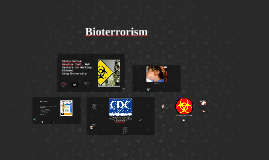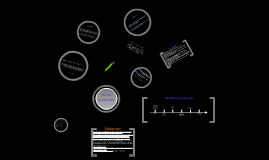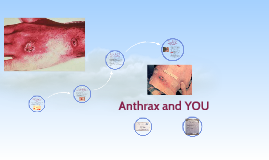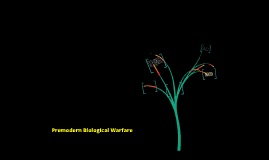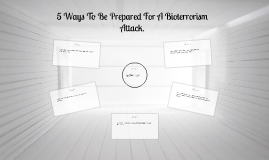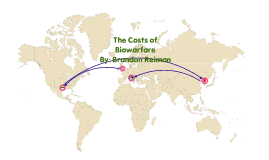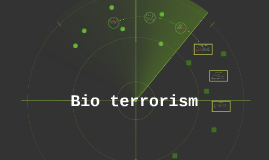Bioterrorism
Transcript: Biological weapons facts The CDC categorizes the agents into A, B and C and regulates the laboratories that can possess, use or transfer select agents within the United States http://www.webmd.com/a-to-z-guides/video/biosignature-fingerprinting The History of Bioterrorism Bibliography agents that are used as weapons of war Category A agents: anthrax, tularemia, smallpox, botulinum toxin, bubonic plague and viral hemorrhagic fevers These are moderately easy to disseminate and have low mortality rates Category A Category C agents: Nipah virus, hantavirus, SARS, H1N1 and HIV/AIDS -Biological weapons are hard to use without endangering ones own troops and population or terrorism United States conscientious objectors were used as consenting test subjects for biological agents in an operation called Operation Whitecoat What are the biological agents? Bioterrorism By Kayleigh Kuchyt -Organisms that can be biological weapons are bacteria, viruses and fungi Letters laced with anthrax were sent to news media offices and US congress; 5 were killed http://ic.galegroup.com/ic/ovic/ReferenceDetailsPage/ReferenceDetails Window?displayGroupName=Reference&disableHighlighting=true&action=e&windowstate=normal&catId=GALE%7C00000000LVVH&documentId=Gale%7CPC3021900023&mode=view&userGroupName=s2041&jsid=bd1ee0a6686c5d2169f55574ccbfec28 Biological weapons: live, disease-causing -They can be 100 to 1,000 times as effective in killing people as -They are hard to detect because they can be invisible and have no odor or taste There are three methods of EW: -Infecting insects with a pathogen and then dispersing the insects over target areas -This warfare uses insects to attack an enemy -Using uninfected insects, like bees, Secret Imperial Japanese Army Unit 731 did research on biological weapons, conducted fatal human experiments on prisoners which incluced testing the lethality of certain biological agents and produced biological weapons for combat use during the 2nd Sino-Japanese War Members of the Rajneeshee put salmonella on fruits and vegetables, and in blue cheese dressing, coffee creamers and potato salads at various restaurants and supermarkets; 751 people got sick to kill or incapacitate an enemy Cold War -A direct attack on crops Category C 1995 http://www.fda.gov/ForConsumers/ConsumerUpdates/ucm048251.htm http://www.pbs.org/cgi-bin/wgbh/printable.pl?http%3A%2F%2Fwww.pbs.org%2Fwgbh%2Fnova%2Fbioterror%2Fhist_nf.html Category B agents: brucellosis, salmonella, e. coli, glanders, Q fever and water supply threats like vibrio cholerae These are emerging pathogens that could be engineered for wide dispersion because they are readily available, easy to make and disperse, they have a high mortality rate and they can cause a major health impact -Some are classified as weapons of mass destruction http://en.wikipedia.org/w/index.php?title=Bioterrorism&printable=yes Biological warfare: the use of these weapons 2001 -The effects of biological weapons are killing by poison or disease, destruction of crops or livestock and incapacitating people WWII (1939-1945) 1972 http://www.time.com/time/printout/0,8816,176937,00.html Entomological Warfare http://blog.dhs.gov/2011/10/s-supporting-our-biodefense-system-to.html Category B 1984 These are high-priority agents that pose a risk to national security, can be easily transmitted and dispersed, result in high mortality and have a potential for major public health impact In Chicago two college students were arrested for planning to poison the city's water supply with typhoid -They have a long incubation time, in between when they are dispersed and when disease symptoms first start -They are easy to make and cost less to make than nuclear and conventional weapons do Bioterrorism: terrorism involving the intentional release or dissemination of biological agents -Biological agents can cause widespread fear and panic beyond the actual physical damage they can cause http://en.wikipedia.org/w/index/php?title=Biological_warfare&printable=yes to directly attack the enemy http://www.dhs.gov/files/labs/gc_1166211221830.shtm Aum Shinrikyo released sarin gas in a Tokyo subway; this killed twelve and injured thousands chemical weapons of the same weight






